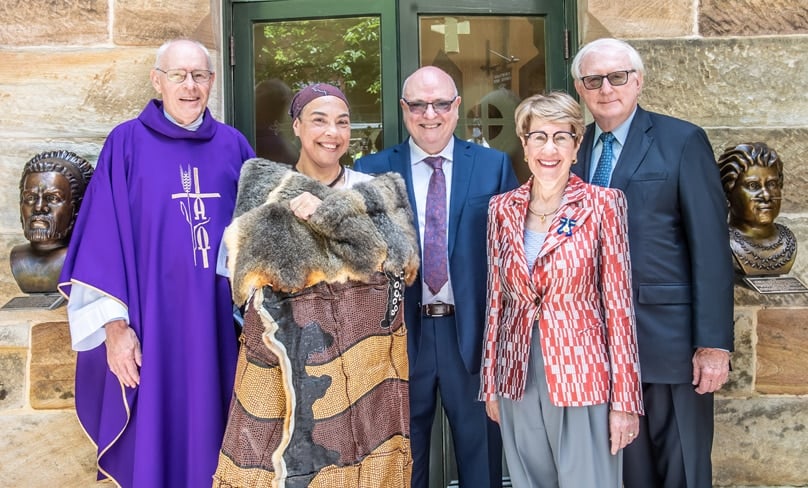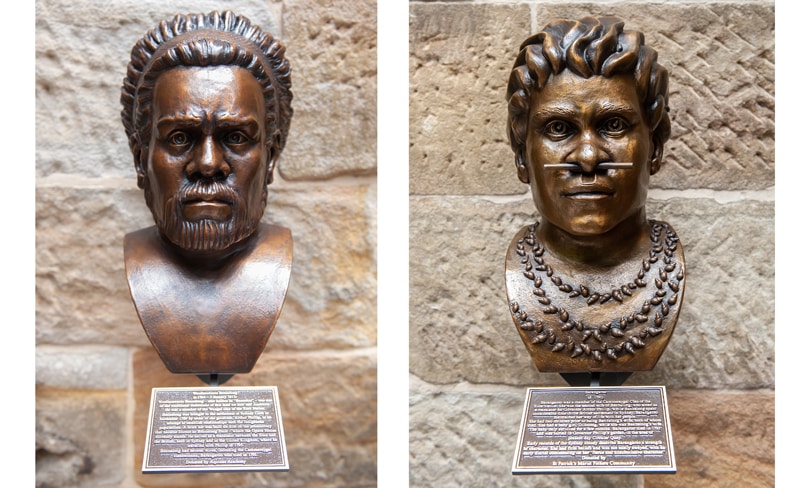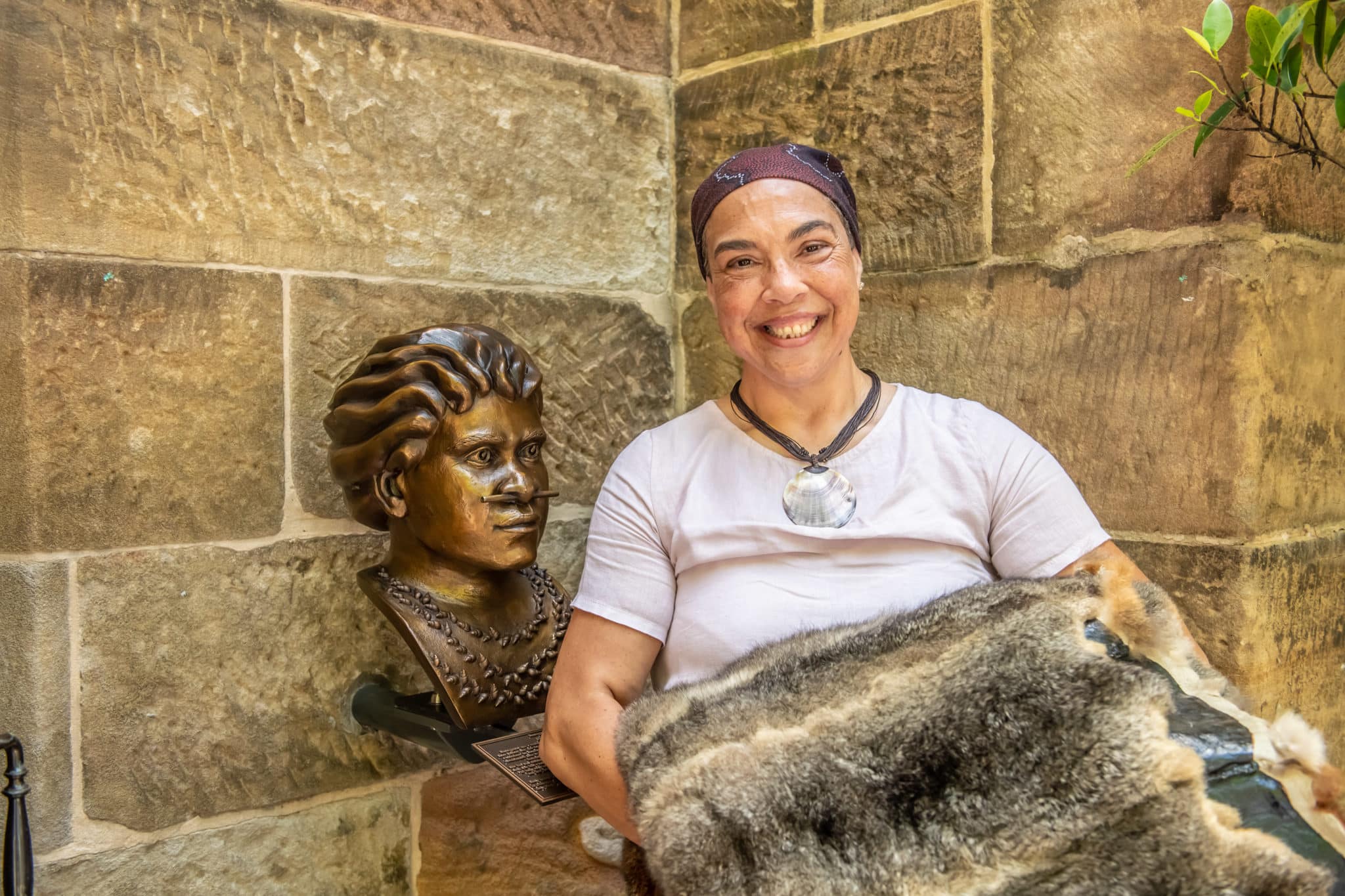
In a landmark step forward for Indigenous Reconciliation, St Patrick’s parish, Church Hill has made history in unveiling what is believed to be the first statues honouring an Aboriginal couple from the early days of the colony of NSW who were both well known as great community leaders of that era.
NSW Governor, the Hon. Margaret Beazley AC QC unveiled the two bronze sculptures honouring Aboriginal leaders, Bennelong and Barangaroo, in a ceremony on 12 December in the St Patrick’s courtyard, directly next to the church on busy Carrington Street.
The sculptures were a labour of love over many months for Sydney sculpturor Roger Apte, who worked under the guidance of Eora woman, Theresa Ardler, who is the Director of Gweagal Cultural Connections, an organisation which provides Aboriginal spirituality and cultural lessons for school-aged children.
At the unveiling of the statues and wearing a budbili or possum-skin cloak, Ms Ardler praised the St Pat’s church community led by Parish Priest, Fr Michael Whelan, for its historic milestone.
“I hope it acts as a permanent reminder to everyone who comes here and the Catholic community in particular, as Pope Francis reminds us, to embrace everyone, no matter what their spiritual beliefs are.”
“Seeing my ancestors acknowledged in this way, makes me very proud indeed. Both Bennelong and Barangaroo left a great mark on society at that time.
“Now, 250 years later, they’re still very well known and loved”, she said.
A senior man of the Eora people, Bennelong served as a mediator between the Eora and the British in the late 18th and early 19th century and travelled with Governor Arthur Phillip to England in 1792.
His wife Barangaroo was also a leader of the Eora nation who provided for the clan’s men with fish caught in and around Sydney Harbour, using a simple black wood canoe and was known for her strong pride in her culture.

Fr Whelan said he hoped the new sculptures remind Sydney Catholics of the long custodianship which many generations of Indigenous people have maintained with the land.
“I hope it acts as a permanent reminder to everyone who comes here and the Catholic community in particular, as Pope Francis reminds us, to embrace everyone, no matter what their spiritual beliefs are”, he explained.
Over countless hours spent preparing the statues in his Brookvale studio, Roger Apte said he was fortunate to be able to draw upon Theresa Ardler’s guidance.
“Theresa even handed me the necklace which Barangaroo’s family had made quite a while ago and that gave me a physical contact with her family and therefore with the subjects I was dealing with as well”, he said.
“Seeing my ancestors acknowledged in this way, makes me very proud indeed. Both Bennelong and Barangaroo left a great mark on society at that time.”
“I hope that visitors to St Patrick’s are able to spend some time with each of these portraits, see what is written in their faces and consider with their minds and hearts the significance of these two people, the times they lived in and consider too, their relationship with us”.
Theresa Ardler said she hopes the new statues invite all Sydneysiders and visitors to the city to learn more about the two historic figures in Aboriginal history.
“Bennelong was one of the best known Aboriginal figures of his time.
“He was far more than just a mediator and interpreter with the British.
“He can actually now help us connect 21st century Australia with the social and spiritual Aboriginal world that existed before the English colony of NSW”, she said.

Ms Ardler said Barangaroo continues to be a powerful role model, especially for women today. “She was influential, independent, strong, worldly-wise and had a much freer spirit than was expected by the settlers of the time”, she said.
The sculpture reflects that aspect of her character well, with a bone through her nose and having painted herself with white clay, both proud statements of her spirituality and culture.
Ms Ardler said she is looking forward to inviting school groups to St Patrick’s Church to reflect upon the great legacy left by these two Indigenous leaders.
“As a mark of the respect he was held in, the governor built him a hut on what became known as Bennelong Point where the Opera House stands today.”
“They were both great ambassadors of the Indigenous culture of the day, leaving a great mark on society at that time”, she said.
“It would have taken great courage on Bennelong’s part to travel all the way to England with the Governor”.
“As a mark of the respect he was held in, the governor built him a hut on what became known as Bennelong Point where the Opera House stands today”.
Given her great passion for fishing, it is fitting that Barangaroo now has a precinct of Sydney around Darling Harbour named in her honour, she added.
Related Articles:
